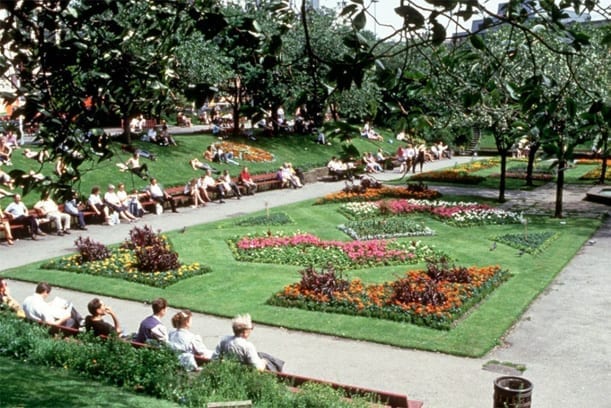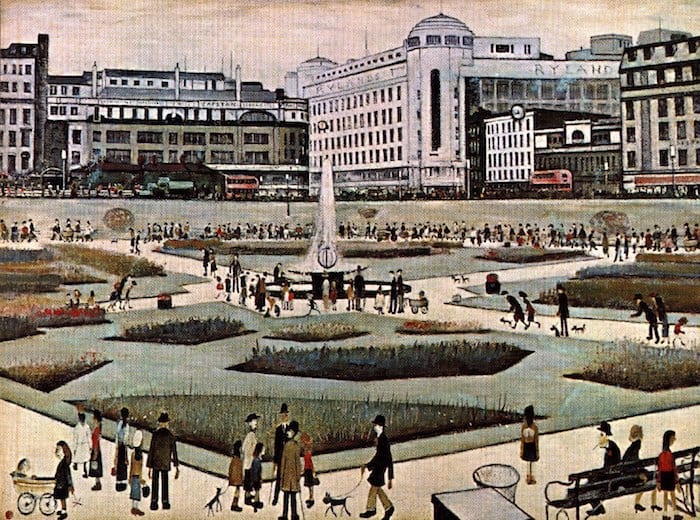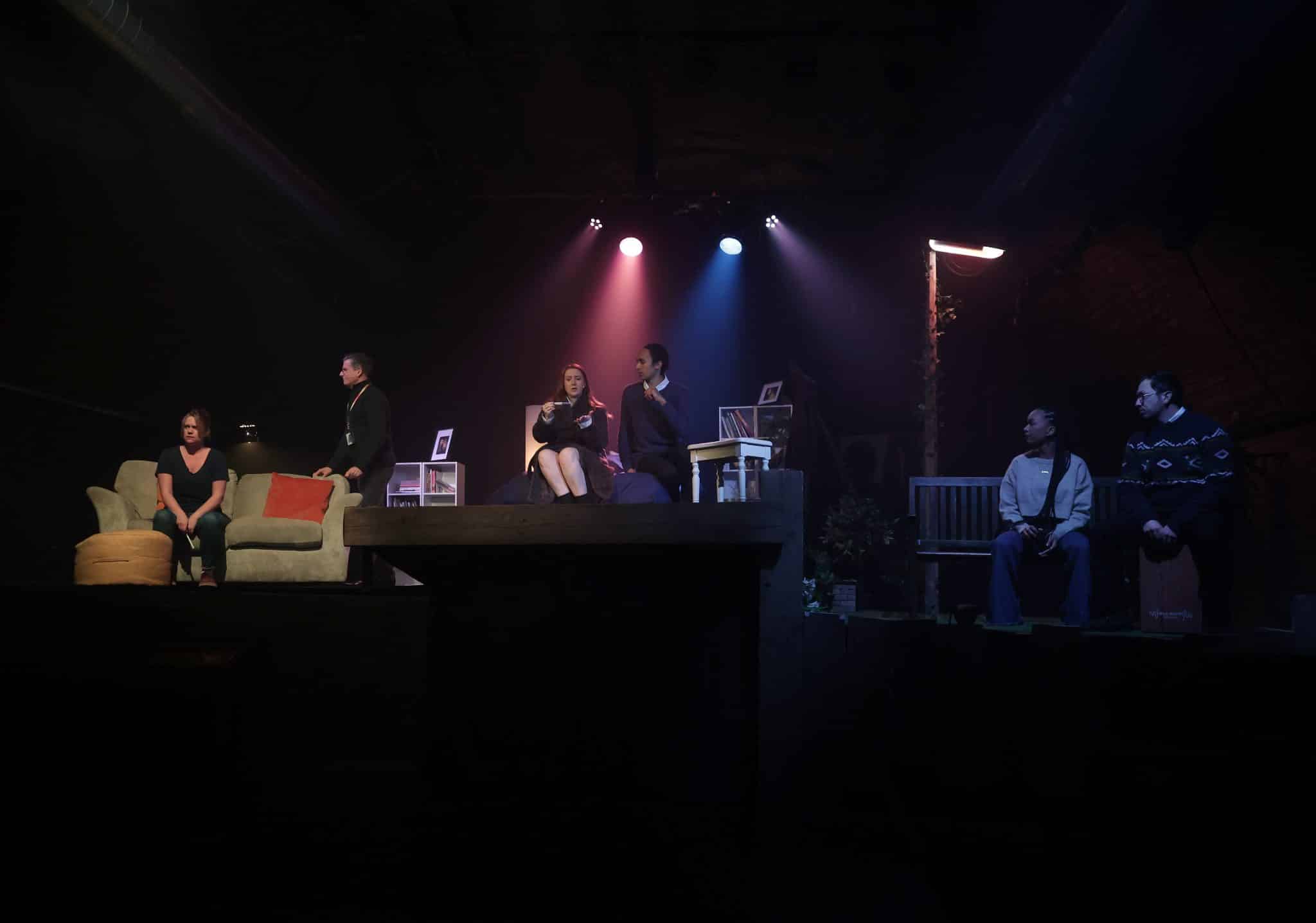The history of Piccadilly Gardens (and how we can fix it)
- Written by Ed Glinert
- Last updated 1 year ago
- History

Manchester has had no idea what to do with Piccadilly Gardens since the Manchester Royal Infirmary was needlessly demolished in 1910.

Manchester Royal Infirmary
Just think how elegant and imposing the area would still look with a grand epic Classical structure and attractive outbuildings, framed by the statues of the great and the not so great that now stand awkwardly framing a building that no longer exists.
Instead, where London has Piccadilly Circus, Paris the Arc de Triomphe and Berlin the Brandenburg Gate at their centres, Manchester has a shabby square of mudded grass and play fountains flanked by disgusting concrete walls, an unnecessary bus station, tram lines and a vile office block.
The Regeneration of Piccadilly Gardens
But now, in Summer 2023, the council has appointed a design team, LDA, based nearby in the Northern Quarter, to “realise its potential as an outstanding, welcoming public space…a world-class space”
We live in hope, but we’ve heard it all before and Piccadilly Gardens deteriorates every year – more eyesores, more mud heaps, more violence.
But wait a minute. Why is the council doing anything at all?
For years, since the beginning of the century, when they ruined the much-loved flower beds when it really was “Gardens”, council leaders have been swatting away all public protest, telling us how fantastic Piccadilly Gardens is.

Until he stepped down as council leader, not a week went past without Richard Leese tweeting pictures of people using the area to show how popular it was, cleverly failing to mention that if you have an open space, people in a crammed city centre will gravitate there, no matter how horrible it is.
They have no choice!
The council knew during the cleaning up of the city after the 1996 bomb (not that Picc Gardens was affected) that in scrapping the flower beds and building the Berlin Wall the public would hate it and would complain forever until it was eliminated.
When I first saw what we now call the Berlin Wall, I thought it was a piece of masonry left behind by accident when the redevelopment was finished.
The Fall of the Berlin Wall (in Manchester)

They would be taking it away tomorrow.
It’s still there!
Laughably, a posting went out a few years ago during Covid that the hated wall had come down.
I turned up the next day with a bottle of champagne and some petit fours only to see it still standing there in all its monstrous ugliness.
“Oh, we chopped down the little wall next to the Japanese tree,” a councillor explained.
Big deal!
So we were right all along, Richard. Piccadilly Gardens is a disgrace.
Manchester can’t claim to be a major international city until this area is completely revamped.
International visitors arrive and laugh.
Is that the best you can do?
But before we look at possible schemes, let’s ask ourselves why it is such a mess.
Why is it that the city that gave the world some of the greatest designs in modern culture through Peter Saville and Factory Records; the city bursting with imaginative design teams and creative forces is not making use of the talented folk at its disposal?
Look at the Metrolink map and then at the London Underground map.
Embarrassing.
Meanwhile, the council never display any interest in design; merely in making money.

When they revamped Piccadilly Gardens they hired Tadao Ando, winner of the most prestigious of all architecture prizes, the Pritziker, and then let him come up with that nonsense!
Where was the quality control?
Same with Norman Foster in Spinningfields.
The office block with Pret at the base. Really? Did Foster sign it off unseen?
So now we once again have a team of designers and city elders looking to revamp Picc Gdns.
We’ve seen it all before.
Eamonn O’Neal of Manchester Evening News fame set up a working party around ten years ago.
The result? A tiny slice of the Berlin Wall was removed and further decline of the square.
As Manchester’s leading historian and tour guide, bursting with ideas, I applied to join. Never heard nuffink.
Now let us look at what has happened to Piccadilly Gardens over the years. In pre-industrial times the land was covered by the daub holes from which people took their clay to build houses.
The ponds became ornamental lakes in the late 18th century when Oswald Mosley, Lord of the Manor of Manchester, donated the land to the authorities for building an infirmary.
After the infirmary moved to Chorlton-on-Medlock in 1908 it seemed the building might become either a reference library, a new Exchange or an art gallery. Instead, it was demolished in 1910 and the site was landscaped.

The authorities now turned their attention to the Infirmary’s replacement.
One idea was for a vast cathedral, but the plan came to nothing.
Manchester Opera House
In 1917, the conductor Thomas Beecham announced “I will build in Manchester an opera house that shall be of size and importance not less than those of any other opera house in London or any continental towns with the exception of Paris and Petrograd”.
He then went bankrupt.
In the 1930s formal flower beds were laid out as a temporary measure.
A bland and predictable choice, they were at least popular and provided Mancunians with a rare patch of attractive open space in the heart of the city.
A glimpse of how they looked can be gained from L. S. Lowry’s 1954 painting Piccadilly Gardens.

Then came the 1990s with councillors itching for change.
So they uprooted the flower beds and sunken levels and replaced them with a flat lawn, plain and unadorned, which squelches into mud during the long rainy season, that wall and later one of Britain’s most appalling buildings: No. 1 Piccadilly Gardens.
The opportunity to rid the area of the unnecessary bus station was also not taken, its presence meaning that the nearby shopping units have continued to attract mostly bottom-of-the-market outlets.
Although the Mosleys donated the land on condition that it would always be kept for public use, the council sold the space on the Portland Street side of the gardens to a developer, the Argent Group, in the 1990s, and moved the gardens a few yards west.
As shocking as the Berlin Wall is No. 1 Piccadilly Gardens.
The decision to build a new office block here at the beginning of the 21st century gave Manchester the chance to show the world its determination to introduce the best in design and architecture into the city centre.
Instead, Allies and Morrison dropped all the skill they used in revamping London’s King’s Cross area and built what looks like a multi-storey car park.
To add to the absurdity, the bright red brick is merely a decoration, rather than a structural feat, for the 2003 block has a steel frame.
Piccadilly Gardens’ problems in recent months have been exacerbated by the closure of a host of prestigious nearby outlets, leaving decaying buildings: Debenham’s, now a massive empty shell; Santander, gone; the M&S food hall, shut; further down Edward Walters’ magnificent palazzo-styled bank at 38 Mosley Street, empty.
Why so?
Because no one wants to be associated with the area.
How to fix Piccadilly Gardens
Okay, enough moaning. What can be done?
Here are some easy steps that nobody will have the confidence or imagination to enact.
• Avoid all grass. It rains a lot in Manchester. The lawn segues into mud and has to be replanted. It looks pathetic. It’s wrong.
• Scrap all kiddie facilities. Wrong place. No kids live locally.
• Demolish the entire Berlin Wall. So there are a few outlets in it. So what? Caffe Nero’s gone. There are loads of alternative cafes and eateries. The wall was an insult to the people of Manchester. No one wants it.
• Demolish No. 1 Piccadilly Gardens. No more excuses and legal jargon. Come on, Manchester City Council, it’s not difficult. You’ve demolished so much over the years. No new scheme for the Gardens will work while that monstrosity is still there. It will be a waste of money and energy.
• Remove the bus station. Why on earth do huge numbers of buses need to start and end at Piccadilly Gardens? This is what small towns like Bolton do. Come on; this is Manchester: the world’s first and greatest industrial city! Have a look at Manchester’s two main rivals: London and Edinburgh. Buses go from suburb to far off suburb through the city centre. In recent years a number of routes have stopped using Piccadilly Gardens in this way. Good. Get rid of all of them and extend the routes.
• What to put in the space? My original, ingenious and imaginative scheme, which will bring Manchester world-wide kudos, hordes of tourists and massive publicity is for the council to launch an international competition attracting artists to fill the area with sculptures of Manchester’s heroic figures: Alan Turing, George Best, Colin Bell, Sylvia Pankhurst, Tony Wilson, Christabel Pankhurst, Ellen Wilkinson, John Dalton, Louise Da Cocodia. The Gardens already has an unholy mix of figures: the Duke of Wellington, who opposed the ordinary people having the vote; Queen Victoria, who opposed women having the vote; James Watt, who set up business in Birmingham, not Manchester, the rogue; and Robert Peel, who rightly scrapped the Corn Laws and helped stamp out lawlessness.
These four need some new neighbours.
It would cost nothing – they wouldn’t need to be paid – they’d do it for the chance to further their career and for the publicity.
I’ve voiced this idea to various figures and been told that ordinary people – paramedics, school cleaners, and care workers are as worthy. True, but they won’t attract tourists and international publicity.
And how Manchester needs tourists!
Has anyone better ideas?
Let us know at [email protected]
Manchester City Council would like to make clear that there will be public consultation on the designs put forward by LDA (based in the NQ) later in the year.
- This article was last updated 1 year ago.
- It was first published on 2 August 2023 and is subject to be updated from time to time. Please refresh or return to see the latest version.
Did we miss something? Let us know: [email protected]
Want to be the first to receive all the latest news stories, what’s on and events from the heart of Manchester? Sign up here.
Manchester is a successful city, but many people suffer. I Love Manchester helps raise awareness and funds to help improve the lives and prospects of people across Greater Manchester – and we can’t do it without your help. So please support us with what you can so we can continue to spread the love. Thank you in advance!
An email you’ll love. Subscribe to our newsletter to get the latest news stories delivered direct to your inbox.
Got a story worth sharing?
What’s the story? We are all ears when it comes to positive news and inspiring stories. You can send story ideas to [email protected]
While we can’t guarantee to publish everything, we will always consider any enquiry or idea that promotes:
- Independent new openings
- Human interest
- Not-for-profit organisations
- Community Interest Companies (CiCs) and projects
- Charities and charitable initiatives
- Affordability and offers saving people over 20%
For anything else, don’t hesitate to get in touch with us about advertorials (from £350+VAT) and advertising opportunities: [email protected]

The very special toy shop where parents don’t pay a penny is open – and busier than ever

Manchester’s oldest homelessness charity celebrates 40 years of supporting the needy

Games, science and history collide at Manchester’s Science and Industry Museum this winter

Best bars and pubs to watch the football and live sport in Manchester

How Baguley Hall Primary School is nourishing minds with a morning Magic Breakfast
















